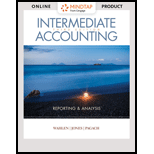
Available-for-Sale Securities
The following are four unrelated situations involving investments in available-for-sale securities:
Situation I
A portfolio of available-for-sale debt securities with an aggregate fair value in excess of amortized cost includes one particular security whose fair value has declined to less than one-half of its amortized cost. The decline in value is considered to be other than temporary.
Situation II
The portfolio of available-for-sale debt securities includes securities that have an amortized cost in excess of fair value of $500. The remainder of the portfolio has a net fair value in excess of amortized cost of $1,000.
Situation III
An available-for-sale debt security, whose fair value is currently less than its amortized cost, is reclassified as a trading security.
Situation IV
A company’s portfolio of available-for-sale securities consists of the bonds of one company. At the end of the prior year, the fair value of the security was 95% of amortized cost, and the effect was properly reflected in an allowance account. However, at the end of the current year, the fair value of the debt security had appreciated to 102% of the amortized cost.
Required:
Explain the effect on classification, earning value, and earnings for each of the preceding situations.
Want to see the full answer?
Check out a sample textbook solution
Chapter 13 Solutions
INTERM.ACCT.:REPORTING...-CENGAGENOWV2
- Held-to-maturity investments applies only to debt securities because ________. A. the classification is dependent on the investor's intention to hold the investment until maturity, and equity securities do not mature on a specific date B. these are long-term investments C. these securities earn periodic interest D. the classification is dependent on the investor's level of influence over the investee companyarrow_forwardA security in a portfolio of available-for-sale securities is transferred to the trading category. The security should be transferred between the corresponding portfolios at: a. book value at date of transfer if higher than the fair value at date of transfer b. fair value at date of transfer, regardless of its cost c. cost, regardless of the fair value at date of transfer d. lower of its cost or fair value at date of transferarrow_forwardWhen an investment in an available-for-sale debt security is transferred to trading because the company anticipates selling the security in the near future, the carrying value assigned to the investment when transferring it to the trading portfolio should be O the higher of its original cost or its fair value at the date of the transfer. O the lower of its original cost or its fair value at the date of the transfer. O its fair value at the date of the transfer. O its original cost.arrow_forward
- A bond investment that satisfy the amortized cost measurement may be designated a. irrevocably at either fair value through other comprehensive income or fair valiue through profit or loss. b. irrevocably at fair value through other comprehensive income c. revocably at fair valiue through profit or loss. d. irrevocably at fair value through profit or lossarrow_forward1. A bond investment that satisfies the amortized cost measurement may be designated a. Revocably at fair value through profit or loss b. Irrevocably at fair value through profit or loss c. Irrevocably at fair value through OCI d. Irrevocably at amortized costarrow_forwardShort-term investments are also called marketable securities. True or False True Falsearrow_forward
- 2) Debt securities which are classified as held-to-maturity securities are valued at amortized costs. Amortized costs is synonymous with carrying value and book value. (True/False)arrow_forwardThe realized gain (loss) on sale of debt investments with an objective of collecting contractual cash flows and to sell when circumstances warrants is the difference of the net selling price and the fair value of the bonds. Group of answer choices False Truearrow_forwardAn investment in debt securities which the investor intends to hold until they mature is classified as A. Trading debt investments B. Significant influence equity investments C. Available-for-sale (AFS) debt investments D. No significant influence equity investments E. None of the abovearrow_forward
- GAAP requires investments in bonds classified as trading securities to be reported at their: A. fair value. B. net realizable value. C. maturity value. D. historical cost.arrow_forwardHello, Under IFRS 9, companies that invest in equity securities choose from which of the following options for reporting their investing? a. FV-NI only b. FV-NI or FV-OCI c. Amortized cost or FV-NI d. Amortized cost or FV-OCIarrow_forwardsend helparrow_forward
 Intermediate Accounting: Reporting And AnalysisAccountingISBN:9781337788281Author:James M. Wahlen, Jefferson P. Jones, Donald PagachPublisher:Cengage Learning
Intermediate Accounting: Reporting And AnalysisAccountingISBN:9781337788281Author:James M. Wahlen, Jefferson P. Jones, Donald PagachPublisher:Cengage Learning Cornerstones of Financial AccountingAccountingISBN:9781337690881Author:Jay Rich, Jeff JonesPublisher:Cengage Learning
Cornerstones of Financial AccountingAccountingISBN:9781337690881Author:Jay Rich, Jeff JonesPublisher:Cengage Learning


